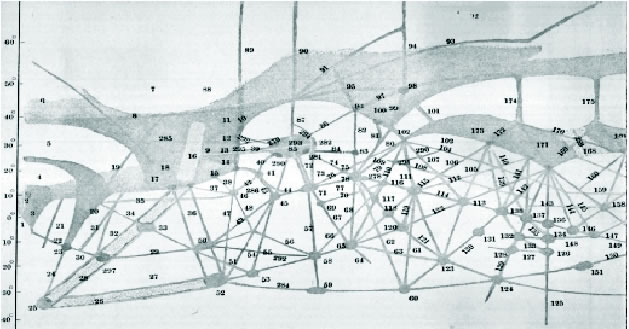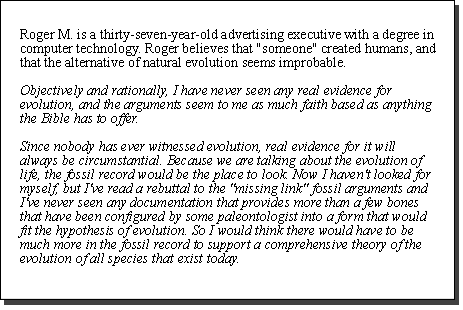
“Man will occasionally stumble over the truth, but usually manages to pick himself up, walk over or around it, and carry on.” [Winston Churchill]
One out of every four Americans believe we can communicate with the dead. A comparable number think the sun revolves around the Earth, not vice versa.
Many of us believe strongly in something despite a lack of reliable evidence to support it. Our beliefs are the result of normal mental processes operating on information in unusual ways. We think we base our opinions on facts and experience, but personal bias shapes them. Our emotions conspire with logic to generate beliefs that can persist despite overwhelming evidence to the contrary. Rarely is this more evident than in our beliefs about human origins.
Before we can weigh the arguments on all sides of the human origins debate, we must take a frank look at our psychology of (mis)belief.
Mind Matters
In his book How We Know What Isn’t So, psychologist Thomas Gilovich reveals the mental gymnastics we go through to rationalize and defend our beliefs. The title of his book grasps the dual nature of our psychology of belief. That same mental agility we rely on to know right from wrong can turn on us, seducing us into embracing “truth” that just doesn’t exist. Four powerful elements in our psychology of (mis)belief illustrate how we unconsciously make mental errors:
1. Misinterpretation of randomness and chance
Random events are independent of all prior events. For example, one hundred random tosses of a coin will statistically yield fifty heads and fifty tails. Each toss has no influence on the outcome of the next. Since a coin has no memory, the chance that a toss of two tails will be followed by heads is still only fifty-fifty. But if we get a long series of tails before heads appears, as shown in Figure 2.1, we sense that something is wrong.

Fig. 2.1 Which of these series of coin tosses looks most random to you?
All three sequences in Fig. 2.1 are randomly generated tosses in which the chance that heads or tails would come up next was always fifty-fifty. Runs of four or five of the same side of the coin are within the limits of statistical probability. But our mind detects a pattern and we believe that if the coin toss is fair and unbiased, then heads (or tails) is due.
The notion that a particular random event is due can lead us to believe that an active cause is governing the outcome of the process. We might say that the cause is explainable (a loaded coin) or unexplainable (bad luck).
It’s easy to detect patterns in random events, especially when the sample size is small. We are tempted to associate these patterns with a specific cause. Then we use this cause to explain the outcome of future events. The psychological equivalent of this in sports is the “hot hand.”
The phenomena of a “hot hand” is generally accepted by basketball players and fans alike who know the thrill of watching someone who just can’t seem to miss. After all, when you’re hot your hot! But Gilovich has shown that this widely held belief has no basis in fact. He and his colleagues analyzed National Basketball Association performance statistics, and found no evidence for clusters or streaks of successful shots beyond those determined by chance alone.
Next, Gilovich’s group examined the possibility that one successful shot increases the likelihood of success on the next try — the true definition of a “hot hand.” They analyzed both the order and outcome of shots at the free throw line where defensive pressure and difficulty of the shot are equal for all players. If success really does breed success, then players making their first free shot should be more likely to score on the second. But the numbers say no. Gilovich found that a player making the first free throw had a 75% chance of making the second, and a player who missed his first try also had a 75% chance of success on the second. Skill is certainly a factor in the success of every throw. But each toss is a statistically independent event, not influenced by the result of the prior throw.
During a college football season match-up between powerhouse rivals Florida State University and the University of Florida, commentators reported that the pre-game strategy of the University of Florida coach was to alternate his two quarterbacks in and out of the game until he saw which quarterback had a “hot hand.” Apparently neither had one since Florida State won the game. But belief in the “hot hand” persists, confirming our misunderstanding of the nature of random events and chance.
2. Connecting random events
A kissin’ cousin to the “hot hand” is our tendency to actively search for patterns and relationships in random information. Our brain and eyes are adept at drawing connections. It’s an important survival instinct that helps us understand and control our environment. We see a similarity among objects or events and assume that like goes with like. We organize random bits of information into coherent patterns, then fashion stories to explain the connections we’ve made. But this instinct can run amok, leading to errors in judgment and beliefs based on false connections.
In 1894 astronomer Percival Lowell built an observatory in Flagstaff, Arizona to take advantage of the clear viewing made possible by the high altitude and dry desert air. He was eager to observe the “canali” on Mars that had been reported twenty years earlier by the Italian astronomer Schiaparelli.
During the next fifteen years Lowell made countless observations and detailed drawings of the surface of the Red Planet. He became convinced there were canals on Mars and speculated that intelligent beings used them to transport water to their cities from the planet’s icy polar regions (see Figure 2.2). Lowell published his theories and maps of Mars in three books Mars (1895), Mars and Its Canals (1906), and Mars As the Abode of Life (1908).
Over the next several years Lowell made many important contributions to the field of astronomy, but he remains best known for his canals on Mars. Lowell’s suggestion that an advanced civilization had built the canals created an immediate sensation and launched our modern day search for extraterrestrial life.

Fig. 2.2 Percival Lowell drew this map of Mars depicting canals that he believed were evidence of intelligent life on the planet.(Courtesy Eric Hutton)
Today we observe Mars through more powerful telescopes and land space probes on the planet’s surface. There are no canals, and no evidence exists for intelligent life on Mars. What had Lowell seen? When Lowell viewed Mars through its turbulent atmosphere, his eyes instinctively drew lines between the darker areas on the planet’s surface. The canals were optical illusions, false patterns generated by mental processes. Lowell’s theories about Martian cities were stories conjured up to explain the patterns he thought he saw.
3. Biased selection of evidence

It’s been said that bias is when the opinion of the other person is different from our own. Roger’s arguments illustrate an extreme form of bias captured in song by the 1940’s singing sensation Bing Crosby when he crooned Johnny Mercer’s tune, “You gotta Accentuate the Positive and Eliminate the Negative.”
Roger takes the Bing Crosby approach to the evidence for human origins. He accentuates any argument in favor of his belief in creation and eliminates the negative. While interviewing Roger, I got the impression that there could never be enough of the right kind of evidence in support of evolution to change his bias against it. His will to believe in divine creation is so strong that he sifts through facts and arguments to find support for what he believes, then eliminates the rest …